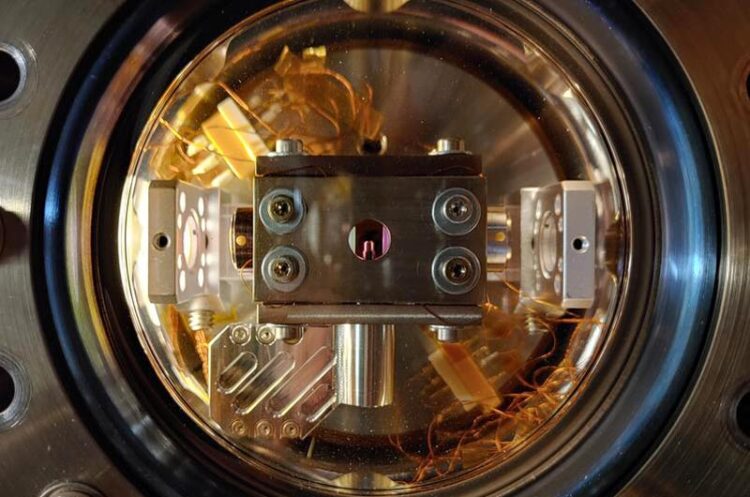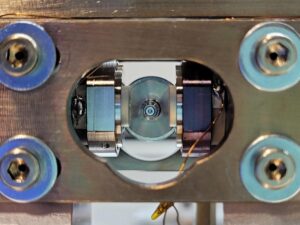Two-dimensional quantum freeze

The vacuum chamber with the experimental setup to levitate a particle inside of a cavity. The cavity consists of two mirrors coated to be extremely reflective for infrared light. The cylindrical part in the center holds a lens at its tip.
(c) Johannes Piotrowski
Researchers at ETH Zurich and TII Abu Dhabi, with the support of quantum optics theorists from Innsbruck, Austria, have succeeded in simultaneously cooling the motion of a tiny glass sphere in two dimensions to the quantum ground-state. This represents a crucial step towards a 3D ground-state cooling of a massive object and opens up new opportunities for the design of ultra-sensitive sensors.
Glass nanoparticles trapped by lasers in extreme vacuum are considered a promising platform for exploring the limits of the quantum world. Since the advent of quantum theory, the question at which sizes an object starts being described by the laws of quantum physics rather than the rules of classical physics has remained unanswered.
A team formed by Lukas Novotny (Zurich), Markus Aspelmeyer (Vienna), Oriol Romero-Isart (Innsbruck), and Romain Quidant (Zurich) is attempting to answer precisely this question within the ERC-Synergy project Q-Xtreme. A crucial step on the way to this goal is to reduce the energy stored in the motion of the nanoparticle as much as possible, i.e. to cool the particle down to the so-called quantum ground-state.
Control over all dimensions of movement

Credit: Dominik Windey
The Q-Xtreme team has been working together on ground-state cooling of nanoparticles for a long time. Several experiments in Zurich and Vienna, supported by theoretical calculations by Dr. Gonzalez-Ballestero and Prof. Romero-Isart at the University of Innsbruck, have led to the first demonstrations of such ground-state cooling of a nanoparticle, either by dampening the particle motion using electronic control (active feedback) or by placing the particle between two mirrors (cavity-based cooling). So far in experiments, the ground state has been achieved only along one of the three directions of particle motion, leaving the motion along the other two directions “hot”.
“Achieving ground-state cooling along more than one direction is key for exploring novel quantum physics,” emphasizes Gonzalez-Ballestero of the Institute for Quantum Optics and Quantum Information at the Austrian Academy of Sciences and the Department of Theoretical Physics at the University of Innsbruck. “But so far this achievement remained elusive as it was challenging to make the mirrors between which the particle is positioned interact efficiently with the motion along some of the three directions” The so-called “Dark Mode Effect” prevented cooling to the full ground state.
With different frequencies towards the goal
Now, the research at the Photonics Laboratory of ETH Zurich has succeeded for the first time in ground-state cooling of a nanoparticle along two directions of motion. A glass sphere, about a thousand times smaller than a grain of sand, is completely isolated from its environment in a high vacuum and held by a strongly focused laser beam while simultaneously being cooled to near absolute zero. Based on theoretical predictions from the Innsbruck team, the Swiss physicists were able to circumvent the dark-state problem. “To do so, we designed the frequencies at which the particle oscillates in the two directions differently and carefully adjusted the polarization of the laser light,” says Lukas Novotny of ETH Zurich.
The work, published in Nature Physics, demonstrates that it is possible to reach the minimum energy state for the three motional directions. It also allows to create fragile quantum states in two directions, which could be used to create ultrasensitive gyroscopes and sensors.
The research was financially supported by the European Research Council ERC and the European Union, among others.
Wissenschaftliche Ansprechpartner:
Carlos Gonzalez Ballestero
Institute for Quantum Optics and Quantum Information
Austrian Academy of Sciences
p +43 512 507-52203
e carlos.gonzalez-ballestero@uibk.ac.at
w https://romeroisartgroup.com
Originalpublikation:
Simultaneous ground-state cooling of two mechanical modes of a levitated nanoparticle. Johannes Piotrowski, Dominik Windey, Jayadev Vijayan, Carlos Gonzalez-Ballestero, Andrés de los Ríos Sommer, Nadine Meyer, Romain Quidant, Oriol Romero-Isart, René Reimann, Lukas Novotny. Nature Physics 2023 DOI: 10.1038/s41567-023-01956-1 https://www.nature.com/articles/s41567-023-01956-1 [arXiv: 2209.15326 https://arxiv.org/abs/2209.15326]
Media Contact
All latest news from the category: Physics and Astronomy
This area deals with the fundamental laws and building blocks of nature and how they interact, the properties and the behavior of matter, and research into space and time and their structures.
innovations-report provides in-depth reports and articles on subjects such as astrophysics, laser technologies, nuclear, quantum, particle and solid-state physics, nanotechnologies, planetary research and findings (Mars, Venus) and developments related to the Hubble Telescope.
Newest articles
Faster, more energy-efficient way to manufacture an industrially important chemical
Zirconium combined with silicon nitride enhances the conversion of propane — present in natural gas — needed to create in-demand plastic, polypropylene. Polypropylene is a common type of plastic found…

Energy planning in Ghana as a role model for the world
Improving the resilience of energy systems in the Global South. What criteria should we use to better plan for resilient energy systems? How do socio-economic, technical and climate change related…

Artificial blood vessels could improve heart bypass outcomes
Artificial blood vessels could improve heart bypass outcomes. 3D-printed blood vessels, which closely mimic the properties of human veins, could transform the treatment of cardiovascular diseases. Strong, flexible, gel-like tubes…





















